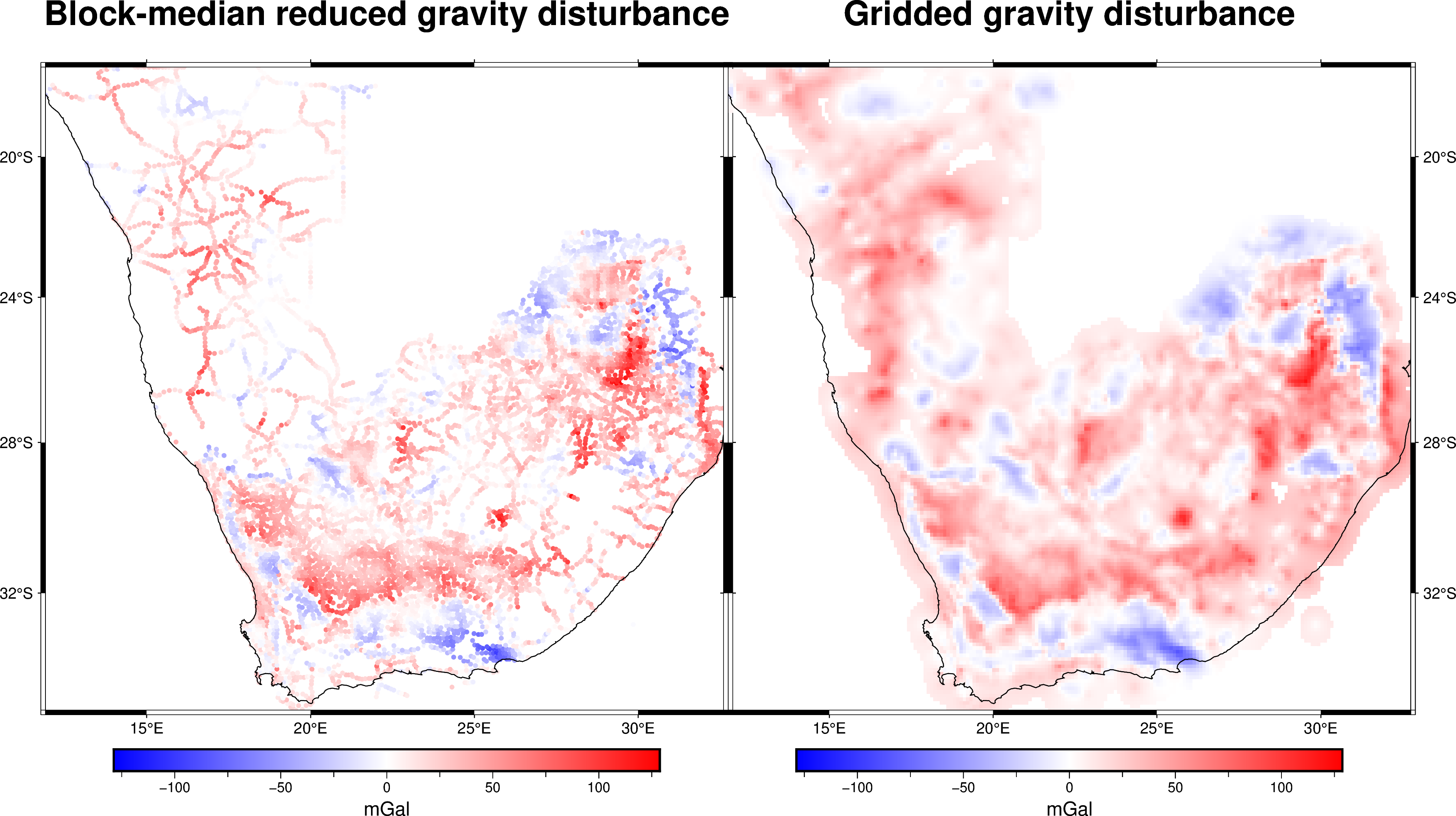Equivalent sources in spherical coordinates#
When interpolating gravity or magnetic data over a very large region that
covers full continents we need to take into account the curvature of the Earth.
In these cases projecting the data to plain Cartesian coordinates may introduce
errors due to the distorsions caused by it.
Therefore using the harmonica.EquivalentSources class is not well
suited for it.
Instead, we can make use of equivalent sources that are defined in
spherical geocentric coordinates through the
harmonica.EquivalentSourcesSph class.
Lets start by fetching some gravity data over Southern Africa:
import ensaio
import pandas as pd
fname = ensaio.fetch_southern_africa_gravity(version=1)
data = pd.read_csv(fname)
data
| longitude | latitude | height_sea_level_m | gravity_mgal | |
|---|---|---|---|---|
| 0 | 18.34444 | -34.12971 | 32.2 | 979656.12 |
| 1 | 18.36028 | -34.08833 | 592.5 | 979508.21 |
| 2 | 18.37418 | -34.19583 | 18.4 | 979666.46 |
| 3 | 18.40388 | -34.23972 | 25.0 | 979671.03 |
| 4 | 18.41112 | -34.16444 | 228.7 | 979616.11 |
| ... | ... | ... | ... | ... |
| 14354 | 21.22500 | -17.95833 | 1053.1 | 978182.09 |
| 14355 | 21.27500 | -17.98333 | 1033.3 | 978183.09 |
| 14356 | 21.70833 | -17.99166 | 1041.8 | 978182.69 |
| 14357 | 21.85000 | -17.95833 | 1033.3 | 978193.18 |
| 14358 | 21.98333 | -17.94166 | 1022.6 | 978211.38 |
14359 rows × 4 columns
To speed up the computations on this simple example we are going to downsample the data using a blocked mean to a resolution of 6 arcminutes.
import numpy as np
import verde as vd
blocked_mean = vd.BlockReduce(np.mean, spacing=6 / 60, drop_coords=False)
(longitude, latitude, height), gravity_data = blocked_mean.filter(
(data.longitude, data.latitude, data.height_sea_level_m),
data.gravity_mgal,
)
data = pd.DataFrame(
{
"longitude": longitude,
"latitude": latitude,
"height_sea_level_m": height,
"gravity_mgal": gravity_data,
}
)
data
| longitude | latitude | height_sea_level_m | gravity_mgal | |
|---|---|---|---|---|
| 0 | 19.394500 | -34.919505 | 0.00 | 979750.15 |
| 1 | 19.465000 | -34.953000 | 0.00 | 979751.50 |
| 2 | 19.554000 | -34.996000 | 0.00 | 979750.20 |
| 3 | 19.748000 | -34.979000 | 0.00 | 979747.00 |
| 4 | 19.299585 | -34.832660 | 0.00 | 979726.95 |
| ... | ... | ... | ... | ... |
| 8072 | 15.896660 | -17.395000 | 1104.30 | 978169.29 |
| 8073 | 15.973330 | -17.390000 | 1106.40 | 978170.99 |
| 8074 | 16.068330 | -17.390000 | 1110.25 | 978168.94 |
| 8075 | 16.140000 | -17.390000 | 1112.50 | 978168.79 |
| 8076 | 18.408330 | -17.391660 | 1115.90 | 978157.49 |
8077 rows × 4 columns
And compute gravity disturbance by subtracting normal gravity using
boule (see Gravity Disturbance for more information):
import boule as bl
ellipsoid = bl.WGS84
normal_gravity = ellipsoid.normal_gravity(data.latitude, data.height_sea_level_m)
gravity_disturbance = data.gravity_mgal - normal_gravity
Lets define some equivalent sources in spherical coordinates. We will choose
some first guess values for the damping and depth parameters.
import harmonica as hm
eqs = hm.EquivalentSourcesSph(damping=1e-3, relative_depth=10000)
See also
Check how we can estimate the damping and depth parameters using a cross-validation.
Before we can fit the sources’ coefficients we need to convert the data given
in geographical coordinates to spherical ones. We can do it through the
boule.Ellipsoid.geodetic_to_spherical method of the WGS84 ellipsoid
defined in boule.
coordinates = ellipsoid.geodetic_to_spherical(
data.longitude, data.latitude, data.height_sea_level_m
)
And then use them to fit the sources:
eqs.fit(coordinates, gravity_disturbance)
EquivalentSourcesSph(damping=0.001, relative_depth=10000)In a Jupyter environment, please rerun this cell to show the HTML representation or trust the notebook.
On GitHub, the HTML representation is unable to render, please try loading this page with nbviewer.org.
EquivalentSourcesSph(damping=0.001, relative_depth=10000)
We can then use these sources to predict the gravity disturbance on a regular grid defined in geodetic coordinates. We will generate a regular grid of computation points located at the maximum height of the data and with a spacing of 6 arcminutes.
# Get the bounding region of the data in geodetic coordinates
region = vd.get_region((data.longitude, data.latitude))
# Get the maximum height of the data coordinates
max_height = data.height_sea_level_m.max()
# Define a regular grid of points in geodetic coordinates
grid_coords = vd.grid_coordinates(
region=region, spacing=6 / 60, extra_coords=max_height
)
But before we can tell the equivalent sources to predict the field we need to convert the grid coordinates to spherical.
grid_coords_sph = ellipsoid.geodetic_to_spherical(*grid_coords)
And then predict the gravity disturbance on the grid points:
gridded_disturbance = eqs.predict(grid_coords_sph)
Lastly we can generate a xarray.DataArray using
verde.make_xarray_grid:
grid = vd.make_xarray_grid(
grid_coords,
gridded_disturbance,
data_names=["gravity_disturbance"],
extra_coords_names="upward",
)
grid
<xarray.Dataset> Size: 595kB
Dimensions: (northing: 177, easting: 209)
Coordinates:
* easting (easting) float64 2kB 11.91 12.01 12.11 ... 32.65 32.75
* northing (northing) float64 1kB -35.0 -34.9 ... -17.49 -17.39
upward (northing, easting) float64 296kB 2.622e+03 ... 2.62...
Data variables:
gravity_disturbance (northing, easting) float64 296kB 5.957 5.986 ... 3.892Since the data points don’t cover the entire area, we might want to mask those grid points that are too far away from any data point:
grid = vd.distance_mask(
data_coordinates=(data.longitude, data.latitude), maxdist=0.5, grid=grid
)
Lets plot it:
import pygmt
maxabs = vd.maxabs(gravity_disturbance, grid.gravity_disturbance.values)
fig = pygmt.Figure()
# Make colormap of data
pygmt.makecpt(cmap="polar+h0",series=(-maxabs, maxabs,))
title = "Block-median reduced gravity disturbance"
fig.plot(
projection="M100/15c",
region=region,
frame=[f"WSne+t{title}", "xa5", "ya4"],
x=longitude,
y=latitude,
fill=gravity_disturbance,
style="c0.1c",
cmap=True,
)
fig.coast(shorelines="0.5p,black", area_thresh=1e4)
fig.colorbar(cmap=True, frame=["a50f25", "x+lmGal"])
fig.shift_origin(xshift='w+3c')
title = "Gridded gravity disturbance"
fig.grdimage(
grid=grid.gravity_disturbance,
cmap=True,
frame=[f"ESnw+t{title}","xa5", "ya4"],
nan_transparent=True,
)
fig.coast(shorelines="0.5p,black", area_thresh=1e4)
fig.colorbar(cmap=True, frame=["a50f25", "x+lmGal"])
fig.show()
